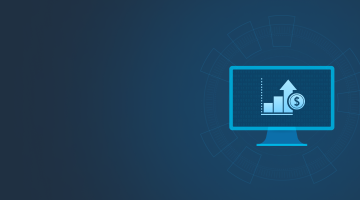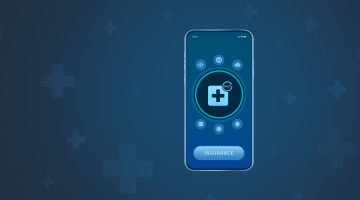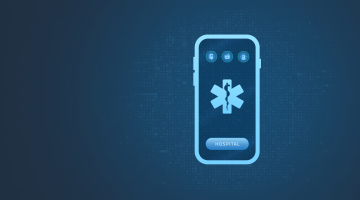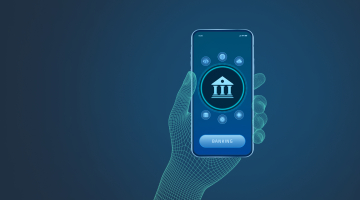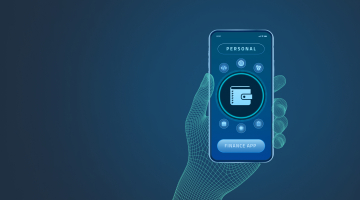
Telemedicine app development: From a concept to the launch of a product
The vicious onslaught of the ruthless COVID-19 that we have recently survived has manifested the harsh truth: effectively combatting global challenges with old-school practices is impossible. Humankind must use the latest technological advancements to let its healthcare efforts live up to the imperatives of the current moment. And what is the high-tech device that reigns supreme in most areas today — from shopping and entertainment to work and studying? You are quite right — it is a smartphone.
Seeing their ubiquity, organizations across all industries launch mobile apps that help them streamline their internal pipeline and reach out to their customers. The healthcare industry is moving in the wake of this overall trend, with a heavy emphasis on telemedicine development.
Check out our telemedicine app development services.
What is a telemedicine app?
The word “telemedicine” is the first element that can be key to its correct interpretation. “Tele” is the Greek for “distant, far-off”; thus, the essence of telemedicine lies in creating an online communication and interaction channel between medical services providers and consumers in different places.
What is the typical use case of telemedicine app development solutions? A person with some health problem contacts their physician via the application and voices their complaints. The doctor examines the patient via live camera streaming (or looks at the photos sent by the client), establishes the diagnosis, and outlines the treatment.
However illustrative, this example doesn’t cover all aspects of the employment of telemedicine. In fact, such video calls are the core of rendering telehealth services that include sharing and analysis of medical data, monitoring therapy progress, convening clinical conferences where doctors can discuss diagnosing and the way of treatment, and other shop floor operations in the realm. Moreover, telemedicine software development can deliver specialized eHealth solutions instrumental in non-clinical use cases, such as training, education, administration, etc.
The need for telehealth products became apparent about a decade ago when the shortage of specialists (which in the US alone can amount to 139,000 within ten years) and the urgency of service delivery called for immediate action. In 2017, an average American had to wait for 24 days to get an appointment with a doctor, and in some cities, this period amounted to an outrageous 51 days! With the outbreak of Coronavirus, such terms are likely to have increased. Besides, the necessity of non-contact means of rendering healthcare services has become a top priority for clients who wanted to minimize contamination risks and healthcare institutions that were overwhelmed by the deluge of patients. At the same time, the plague continued to wreak universal havoc.
Given such high demand for eHealth solutions, it is no wonder that telemedicine carries the day among other digital initiatives in the medical field.
Hospitals worldwide implement telemedicine products on a large scale, triggering a global market boom in this niche. If a few years ago, the market was worth almost $50 billion, by the end of this year, it is expected to display an almost four-fold growth and reach an astounding $194 billion! Such breathtaking figures are the best proof of the fact that there are some weighty boons telehealth app development can bring to stakeholders in the domain.
Benefits of telemedicine apps
There are two categories of people who find telehealth apps most useful. What do patients get by embracing these IT products?
- Enhanced accessibility and inclusivity. With the number of mobile gizmos twice as much as the population of the Earth, telemedicine has become available to a huge and ever-increasing pool of healthcare service consumers. This telemedicine branch is known as mHealth, and it is sure to gain significant traction and greater user reach, extending to people whenever and wherever they need it. Such digitalized help is especially attractive for underserved audiences who have limited mobility opportunities, such as seniors or patients with chronic diseases.
- Timesaving. Many people at least once experienced a stomachache on a Friday evening and had to endure it till Monday when their doctor came on duty. In some more serious cases, when every minute is crucial, the delay may result in severe consequences or even become fatal. On-demand access to physicians allows patients to receive a consultation instantly and address the problem on short notice if its urgency requires it.
- Cost-efficiency. Since people don’t have to travel to the hospital (and in some distant or sparsely populated areas, it may be quite a long way), they save on fare, fuel, and other related expenses.
- High quality of services. Modern telehealth solutions enable patients to send and receive the results of X-rays, MRT, or lab tests, empowering doctors to make knowledgeable and data-driven diagnoses and treatment decisions.
- 24/7 health tracking opportunities. Telemedicine apps can “inhabit” smartphones and a slew of smart wearable devices, such as watches, wristbands, bracelets, or glasses. These IoT healthcare solutions are honed to permanently monitor a person’s pulse rate, glucose index, blood pressure, or other critical parameters and send them to the doctor in real-time. Having such data always at their fingertips, physicians can react instantly if the patient’s condition is endangered. Moreover, using these gadgets powered by respective firmware promotes the personalization of medical services and enables clinicians to prioritize prevention over treatment.
The perks of onboarding telemedicine apps for healthcare providers are also substantial, and sometimes, they dovetail into the patient’s benefits.
- Again accessibility. Homecare and discharged patients require regular attention and post-treatment supervision. With a telemedicine app, a doctor can monitor such people, check out their condition, and provide recommendations from their workstations in the hospital.
- More timesaving. Doctors always feel time-squeezed and have to do multiple errands during their day on duty. Patients with minor indispositions are especially notorious, as they sometimes demand disproportionate attention and consume precious time. Telehealth apps enable physicians to treat several patients simultaneously and find time to attend to other responsibilities.
- Improved time management. Thanks to telemedicine apps, individual specialists and entire clinics can optimize and facilitate medical services, minimize the number of cancellations and missed appointments, regulate patient flows, and step up their scheduling routine. These measures increase the efficiency of medical care and mitigate doctor burnout risks resulting from excessive workload.
- Cost-efficiency revisited. Digitalizing the workflow allows clinics to reduce receptionist service expenditures and save on buying paper, which is much less needed now. Self-employed doctors stand for even more significant financial benefits because leveraging mHealth solutions spells no need to fork out enormous sums on renting office space and utility payments.
- Less red tape. Doctors often complain that they spend or rather waste up to 70% of their working time on a paper-related routine. With telemedicine apps, all documents are in e-format, which streamlines the lion’s share of red-tape procedures clinicians detest so much.
- Integration with Electronic Health Records (EHR). The round-the-clock availability of every patient’s medical and personal information provides a 360 view of people and enables data-driven insights into diagnosing and choosing treatment.
- Broad collaboration opportunities. The global reach that telemedicine offers help get in touch with remote colleagues, discuss complex cases, and opt for the best solution to the problem together.
- Advanced training of medical students. Modern digital technologies are powerful educational tools. Bolstered with AR and VR know-how, telemedicine apps can facilitate the process of learning and foster hands-on skills without involving human patients.
However weighty the listed benefits may be, telemedicine app developers should know the pitfalls awaiting them on the road to eHealth solution implementation.
Challenges that telemedicine apps face
As a long-time expert in the field of healthcare products, DICEUS is well aware of the obstacles medical service providers can encounter when they embrace telemedicine apps.
Culture and behavior
It is not only about the routine of a standalone hospital but also about the sluggishness, reluctance, or even resistance endemic to such a conservative industry as healthcare. In this complex and even intricate realm, many processes are intertwined and path-dependent on other methods, so attempts to transform one trigger a chain reaction in different sectors. That is why initiators of digitally-driven changes will have to struggle against the status quo.
The primary factor preventing the successful introduction of telemedicine into a clinic’s workflow is the universal buy-in of stakeholders. This should include all doctors, nurses, lab assistants, other hospital medical personnel, healthcare facility administration, and local and regional authorities. If any of these groups lack motivation, harnessing telemedicine will proceed in fits and starts or even bog down altogether.
DICEUS is a hospital management software development company that can help you overcome the challenges of developing a custom telemedicine app.
Awareness of patients
If people don’t know about the telemedicine app or certain services it can provide, they will never request it. That is why doctors and hospital officials should advertise and propagate the solution and emphasize the perks for health service consumers.
Lack of technical skills
This issue is symptomatic of both doctors and patients. Clinicians are easier to educate since the Medicare institution can launch a training program to teach them the ropes. Patients are more complex to crack as they are people of different ages, backgrounds, and capabilities. Besides, a fair share of patients are seniors or mentally/physically impaired people, which turns mastering a high-tech innovation into a tough row to hoe for them.
There are two possible ways to address this challenge. First, hospitals should survey their customers to discover what devices they feel comfortable using and what functionalities they consider essential. Such feedback should be taken as guidance for developing the app. Second, the app should be user-friendly so that even non-tech-savvy people will find it easy to navigate and operate. This means a varied color scheme, large font size, straightforward layout, and no-frills UI/UX design.
Security, privacy, and compliance
These three factors are why hospitals don’t just use Skype to provide eHealth services. Medical and personal data are sensitive information that wrong-doers can exploit if compromised. Skype doesn’t require the encryption of any data (including health-related ones) and, therefore, is not HIPAA compliant, which increases the chances of medical records being tampered with or leaked.
On the contrary, in line with the Health Insurance Portability and Accountability Act (HIPAA), the security of the telemedicine app, the safety of the connection between devices, and the privacy of the data it gives access to are the top priorities that developers should bear in mind while creating the solution.
Scalability
Nowadays, software, hardware, and infrastructure become obsolete very quickly. Besides, healthcare organizations and their practices are also prone to change and grow, posing a challenge for telemedicine app development. App creators must envisage such fluctuations and make provisions for the scalability potential and flexibility of the solution they are building.
Third-party integrations
Modern software never functions as a standalone product, and telemedicine solutions are no exception. They must play well with electronic health records, wearables, internal systems, and other digital assets. Thus, app developers should realize that they will have to build the telemedicine app into the existing digital environment and enable its seamless operation as a part of a larger ecosystem.
Quality of video
Since tele-doctors establish diagnosis primarily by looking at their device’s screen, the quality of the picture on it is mission-critical. Naturally, it is the camera of the patient’s gadget that, to a greater degree, is responsible for it. Yet, bandwidth issues or weak code can negatively affect live streaming. So, app developers should focus on mitigating such issues.
Payment for services
This is not a technical problem because integrating a payment gateway into the app is feasible. Instead, it is a legislative and procedural matter that should be addressed by administrations and lawmakers. They must ensure specialists are paid for online services and consultations at the same rate as in-person visits at home or in the medical facility.
Evaluation
Stakeholders who use a telehealth app should be able to assess its efficiency and the quality of remote services provided. Telemedicine app creators should use evaluation tools to encourage user experience sharing and conduct feedback analysis. In this way, they can identify unmet healthcare needs and fine-tune the app to optimize its performance and provide more patient-centered and personalized services.
The number of challenges to address in the app creation and implementation process varies depending on the application type.
Experiencing a lack of tech expertise and skills?
Connect with a professional team to address your project challenges.
Telemedicine app types
There are five categories of healthcare apps.
- Urgent on-demand care apps. This is the first app type that comes to mind when we imagine telemedicine in action. To fulfill their purpose, such solutions must have two-way video and audio call features and preferably a text chat to let the service provider and consumer communicate via the most convenient channel. A scheduling capability and the doctor’s access to the patient’s data in EHR would be a definite plus.
- Planned care apps. These are honed to conduct routine examinations of patients and track their condition 24/7. The standard functionalities described above must be enhanced with the store-and-forward feature and capability to retrieve and analyze test results, images, and case history.
- Medical facility apps. Such solutions are tools clinics use to facilitate shop-floor processes and automate routine operations.
- Mental health apps. Here, video and audio chatting functionalities are leveraged to help people cope with anxieties, depression, stress, and other psychological disorders.
- Self-care apps. Such products are helpful for people who choose disease prevention rather than treatment for keeping fit. They are instrumental in monitoring a person’s physical condition and recommending diet and a training system. You can make the most of self-care apps by combining their power with wearable gizmos that track and control a person’s vital health indices (pulse rate, covered walking distance, blood pressure, etc.).
DICEUS expertise in telemedicine application development
DICEUS specializes in telemedicine mobile app development and can deliver digital products in these categories.
Telemedicine mobile apps
Hospitals and medical facilities of any scale can draw extreme value from acquiring a dedicated telemedicine mobile app. Our range of telemedicine app development services can help you smooth out remote communication with patients or clients, closely monitor patients and send alerts when needed, and keep people connected with their doctors while instantly providing updates on their diagnostics and treatment.
Custom EMR and EHR platforms
Implementing a tailored Electronic Medical Records (EMR) system streamlines the storage, organization, and management of crucial employee, administration, and facility data. A custom Electronic Health Records (EHR) solution complements your EMR by covering patient data, including registration details, clinical records, and personal history. As a result, you will eliminate tons of paperwork, securely store records, access data instantly from centralized storage, and easily share it for collaborative treatment and diagnostics.
All-in-one clinical management systems
Healthcare management is a complex task that calls for monitoring and collaboration across various departments within a healthcare facility. There’s also the challenge of handling files and patient management routines. To simplify things, we offer telemedicine app development solutions combining EMR, EHR, and other management capabilities. A custom system can be tailored to your workflow, providing tools and features to streamline your healthcare operations.
Remote patient monitoring
We can create robust connected services with up-to-date telehealth software and tech that provide real-time monitoring. This is incredibly useful in healthcare for keeping tabs on patients’ health, particularly for critical or bedridden patients and those with disabilities. It allows quick responses in urgent situations like seizures, strokes, or heart failure. The software can even send reminders to patients, ensuring they take their medications on time and follow proper treatment measures.
Cloud-based solutions
Healthcare facilities generate massive amounts of sensitive data that must be easily accessible and retrievable. A scalable storage solution is crucial to meet this demand without breaking the bank. This is where cloud-based storage or a custom cloud-powered platform is more than handy. With cloud-based telemedicine development, you pay only for the amount of data you store, and the storage capacity is virtually limitless, accommodating the growing volume of data without straining your budget.
The type of telemedicine solution you plan to build conditions the roster of functionalities it should contain.
Must-have features of telemedicine apps
When embarking on telehealth app creation, you should realize that you will commission two solutions rolled into one. It means that the application will have different sets of features leveraged by two user audiences – patients and doctors. Such capabilities lists can be customized to meet the needs of a particular medicare facility. However, there are some vital features that any telemedicine app should possess.
What functionalities will guarantee a rewarding UX for patients?
- Registration. This is the core feature for many service apps, but in the healthcare domain, it has some peculiarities. First, it should be extra secure to comply with data privacy standards and protect patient-related information from being compromised. Second, the customer should be able to upload documents and files from third-party sources, like an EHR system or social networks.
- Home page. It is the bread-and-butter element of the app, where the user arrives after completing the registration. And it is the starting point of the further user journey in their navigation about the app.
- Profile. Here, the patient enters their data, such as address (both physical and electronic), age, images, insurance policy number, etc. To streamline appointment scheduling, data in the profile should be synchronized with the clinic’s records.
- Medical dossier. It is not only the person’s complete medical history that should be available to them but also the results of previous visits to specialists.
- Search capabilities and doctor reviews. An efficient telemedicine app must enable access to all information about specialists working in the healthcare facility. Patients can choose a clinician with the proper specialty, qualification, and experience by employing a filter system. A good crutch in the selection process is the opinions of people who have used a doctor’s services before and are satisfied or frustrated with the interaction and the quality of medical help.
- Scheduling. As soon as the choice is made, patients can arrange an appointment with the doctor in their timetable (the calendar feature is indispensable to enable it). If the specialist confirms the appointment, the customer should receive a notification with approval.
- Interaction media. The main communication channel is video call capability, but chatting should also be available to discuss details and minor issues.
- Voice control. It is an inclusive feature meant to cater to the needs of people with disabilities and impaired eyesight.
- Push notifications. Their primary purpose is to keep the patient updated about appointments, routine visits to a specialist, prescription renewals, and more.
- Payment gateways. A customer-oriented app should offer people several payment options to let them use the one convenient.
The features that doctors can’t do without comprise
- Profile. In addition to the standard personal information about the clinician (education, specialization, certification, experience), it must contain key hospital workflow details, such as shifts and ratings.
- Access to Electronic Health Records. Efficient medical care is impossible without patients’ dossiers in the EHRs, and the doctor should have 24/7 access.
- Data sharing. Physicians should be able to involve specialized doctors in diagnosing and determining the treatment method. They exchange lab test results, prescriptions, MRT, or X-ray images with colleagues from the same facility or external medical institutions.
- Appointment management. Workload planning is fundamental to daily routine optimization, and a doctor-facing telemedicine app should provide such an opportunity.
- Interaction tools. They are the same for all stakeholders since treatment is a two-way street. However, doctors need more advanced capabilities to record virtual visits. Such files can serve as evidence if there is a conflict between the medical service provider and the consumer. Plus, doctors can return to the recorded sessions later to analyze them and maybe reconsider their previous judgment.
- E-prescriptions. Prescribing pills, injections, and ointments is necessary for visiting a doctor offline. So, there is no reason why it should be otherwise in telemedicine.
- Pharmacy database. This library of online resources is highly instrumental for doctors who can get information about drugs, their application field, limitations, side effects, and ingredients to choose the one that suits a particular use case to a tee.
The implementation of these features requires a corresponding set of technologies.
Tech stack for telemedicine app development
Even before we delve into recommendations regarding the know-how selection, we must mention the departure point – the choice of the operating system. Given the notorious Android/iOS divide, you should opt for either. To maximize the user reach, you can develop two native apps for any device. Alternatively, you can go for cross-platform development and create a product that will blend the best of the two worlds.
The technological toolkit for building telemedicine apps comprises essential software for creating must-have functionalities and cutting-edge know-how to go advanced.
The first group includes:
- Facebook API or Google API for signing in
- WebRTC or RTMP to enable audio and video calls
- REST API or GraphQL to integrate EHR
- MySQL, MongoDB, or PostgreSQL as a database
- Programming languages (Kotlin or Java if it is an Android app, Swift if it is an iOS app, and JavaScript, CSS, HTML, or Vue JS for a web app)
- Node.js, Ruby on Rails, Elixir, or Phoenix for backend development
- Angular, React, or some other JS framework for frontend development
- Twilio to build a chat
- Firebase SDK for push notifications
- Google Calendar API to integrate calendar
- Google Cloud Storage or Amazon S3 as a cloud storage
- Stripe or PayPal for a payment gateway
If you want your app to stand out, enhance it with state-of-the-art know-how.
- Artificial Intelligence. Developers use AI in telemedicine app creation to develop voice search and chatbots. The latter can assist patients in scheduling an appointment or describing the symptoms of their disease. Also, AI-powered mechanisms can help doctors automate simple or repetitive tasks they have to perform.
- Augmented Reality and Virtual Reality. These technologies can usher interactivity into medical practices and revolutionize training routines and surgery room experience.
Now that you know what you need to develop a telemedicine app, it’s time to get down to its creation hammer and tongs.
Estimate project costs
Please share more details of your project with our team.

How to build a telemedicine app: A step-by-step roadmap
With numerous accomplished telemedicine app development projects, we at DICEUS have created a strategy for delivering such products.
Step 1. Idea evaluation
To avoid wasting time and money on a product that no one will buy, you should check your idea’s viability. It presupposes identifying the problem your solution will solve, conducting a thorough preliminary business analysis, gauging the demand for the future app, pinpointing the buyer persona and the target audience, researching the market and competition in the niche, and defining the unique value proposition of your telemedicine solution. Besides, you should closely examine the legislation in the telemedicine domain to ensure your app complies with all relevant regulations.
Step 2. Choosing a monetization scheme
Embarking on an app creation is pointless unless you envisage how your solution will make money. Among potential monetization options, the specifics of the healthcare industry limit your choice to the following three models.
- Subscription plan. You can offer customers monthly, quarterly, or annual plans with a flexible pricing policy.
- Per-minute charge. If you manage the rates properly, it can be a more advantageous revenue channel than subscriptions, with a special focus on B2C companies’ early adopters.
- In-app purchases. They work well for urgent support or intermittent services. Otherwise, they should be combined with upselling or similar monetization mechanisms.
Step 3. Feature roster finalization
When you complete all requirements gathering procedures and understand what type of app you want to build, determine the list of functionalities.
Step 4. Tech stack and team selection
Depending on functionalities, determine the platform, tools, frameworks, programming languages, and other software that will be employed for building them. Also, you must identify the experts who will tackle the task.
A standard team for a medium-size telemedicine app includes a project manager, a business analyst, a DevOps engineer (in case you adhere to this approach to software development), a UI/UX designer, two frontend and two backend developers, and a QA specialist. If the project scope requires it, reinforce certain positions with an additional workforce.
Step 5. Proof-of-concept creation and prototyping
The PoC was developed to test the technical feasibility of future apps. Then, it is transformed into a prototype where an interactive UI (or a succession of clickable screens) presents the product’s appearance.
Step 6. Building an MVP and collecting feedback
This is the first fully functional version of the app. It contains only the essential functionalities and is submitted for trial usage by the test audience. Then, we analyze their feedback to see what they enjoyed about the product and – more importantly – what they didn’t. This information we use as guidelines for doctoring those elements of the app that underperform.
Step 7. The core development
The MVP is used as a skeleton to be amplified and upgraded until we have the finished product with all its features, integrations, and APIs.
Step 8. QA and testing
You can’t deploy the app until the QA team runs dozens of tests to ensure it is secure, functions as expected, and has no bugs to hamstring its operation.
Step 9. Deployment
When the quality of the telemedicine app is verified, we place it in the app stores for users to download.
Step 10. Support and maintenance
We continue cooperating with the customer, introducing minor improvements, fixing issues, and consulting the owner on embracing the solution.
Creating a high-end telemedicine solution is a non-nonsense task only experts can do. Our developers have sufficient industry experience and command of a wide tech stack to deliver a telehealth solution of any size and complexity. Contact us to commission a telemedicine app that will impress you with seamless operation and affordable prices.
Key takeaways
Recent high-tech advancements and the consequences of the global pandemic caused a spike in demand for telemedicine apps that serve as digital interaction channels for doctors and patients. Despite the challenges onboarding such products encounters, they promise numerous perks to healthcare service providers and consumers.
Telehealth applications bring maximum value to all stakeholders if IT specialists employ the proper strategy and tech stack.
FAQ
What are the key features of a telemedicine app?
The key features of a custom telemedicine app should contain user authentication, profile management, appointment scheduling, video and chat consultation, e-prescription, medical records storage, payment integration, doctor search and filters, and more. Some unique functionalities of a telemedicine mobile app may be a symptom checker or medicine order and delivery.
How does telemedicine app development work?
Telemedicine app development involves planning features, designing the user interface, and coding the app for mobile and web platforms. Developers integrate secure video calls, chat, appointment scheduling, and payment systems while ensuring compliance with healthcare regulations like HIPAA or GDPR. After testing for performance and security, the app is launched and maintained with updates and support.
What are the regulatory considerations for telemedicine app development?
Telemedicine apps must comply with healthcare regulations like HIPAA (USA), GDPR (EU), and PIPEDA (Canada) to ensure patient data privacy and security. They also need FDA or MDR (EU) approval if they include medical devices or AI diagnostics. Licensing laws vary by region, requiring adherence to state or national telehealth regulations for doctor-patient interactions.
What are some challenges associated with telemedicine app development?
Firstly, telemedicine app development company must consider healthcare regulations (HIPAA, GDPR, PIPEDA, etc.). Secondly, the tech stack to build an app should be appropriately chosen as well as a list of key and unique functionalities.
How can telemedicine apps improve patient outcomes?
Telemedicine apps improve patient outcomes by increasing access to healthcare, enabling early diagnosis, ensuring timely follow-ups, and enhancing medication adherence through remote monitoring and consultations.
